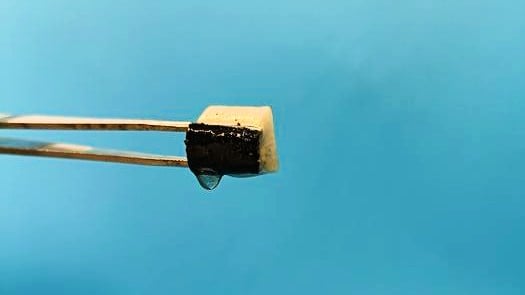A new study reveals a promising solution to freshwater scarcity through an ingenious wood-based material that efficiently harvests moisture from air and converts it to clean drinking water using only solar energy. The novel composite material demonstrates effective performance across diverse humidity levels and temperature conditions, potentially transforming water access in resource-limited regions.
Technology Combines Nature and Science
Researchers from Zhejiang A&F University and RMIT University have developed a remarkable material incorporating delignified balsa wood, lithium chloride, and solar thermal conversion elements to enhance water absorption and retention. The innovative design, published in the Journal of Cleaner Production on February 28, 2025, leverages wood’s natural porous structure while solving common challenges with traditional atmospheric water harvesting methods.
“Billions of people around the world lack access to drinkable water, and millions die from water-borne diseases every year,” said Dr. Derek Hao from RMIT University, who co-authored the study. “Our team has invented a device comprising wood’s spongy scaffolding, lithium chloride, iron oxide nanoparticles, a carbon nanotube layer and other specialised features.”
The material, called WSAWHM (wood-based solar-powered atmospheric water harvesting material), functions through a two-phase process. During nighttime, the sponge-like structure absorbs moisture from the air. When exposed to sunlight during daytime, the material releases this collected water as clean drinking water – completing a natural day-night cycle that requires no external power source.
Impressive Performance Under Diverse Conditions
What makes this technology particularly valuable is its effectiveness across wide-ranging environmental conditions. The research team’s experiments revealed the material functions effectively within relative humidity levels from 30% to 90% and temperatures between 5°C and 55°C – making it suitable for deployment in varied climates around the world.
In laboratory testing, the material absorbed approximately 2.18 grams of water per gram of material at 90% relative humidity after 600 minutes. Perhaps more impressively, it could release 99.9% of the captured water after exposure to simulated sunlight. Even at lower humidity levels (30%), the material maintained significant absorption capacity at 0.63 grams of water per gram.
“In outdoor tests, our device captured 2.5 milliliters of water per gram overnight and released most of it during the day, achieving a daily water collection efficiency of 94%,” said Dr. Junfeng Hou, lead researcher from Zhejiang A&F University.
Beyond its water collection capabilities, the material demonstrates remarkable durability and resilience. It maintained functionality even after being subjected to freezing temperatures of -20°C for 20 days, with the absorbed water remaining liquid – a critical feature for regions with extreme temperature variations.
Advanced Analysis Through Machine Learning
The study incorporated sophisticated machine learning techniques to predict and optimize the material’s performance under varying conditions. The research team employed explainable machine learning models to analyze the relationship between moisture absorption rate, environmental factors, and material composition.
This analytical approach revealed key insights: absorption time, lithium chloride concentration, and relative humidity were identified as the primary factors influencing absorption performance, while temperature had a lesser impact. The resulting predictive models demonstrated exceptional accuracy, with R² values reaching 0.988 for moisture absorption rate prediction using random forest models.
The integration of artificial intelligence into materials science represents a significant advancement in water harvesting technology, allowing researchers to rapidly iterate and optimize designs without exhaustive physical testing.
Practical Applications and Future Potential
The wood-based composite material offers several practical advantages over existing atmospheric water harvesting technologies. Its natural components are widely available, cost-effective, and environmentally friendly. The manufacturing process is relatively simple, enhancing potential for scaled production and deployment in resource-limited settings.
Dr. Hao envisions multiple applications for this technology. “Its ability to harvest potable water from the atmosphere using only sunlight makes it invaluable in disaster-stricken areas where traditional water sources are compromised. The system’s portability and reliance on renewable energy further enhance its applicability in such contexts.”
Looking forward, the research team is exploring partnerships for pilot-scale production and field deployment. They see opportunities to further enhance performance through integration with thermal energy storage systems for round-the-clock operation and IoT sensors for automated control based on environmental conditions.
As global freshwater scarcity intensifies due to population growth, pollution, and climate change, innovations like this wood-based water harvesting material offer a glimpse of more sustainable water collection methods that operate independently of traditional water infrastructure – potentially bringing clean drinking water to the nearly 80% of the global population currently facing water security challenges.
Key Advantages of the Wood-Based Water Harvesting Material:
- Functions effectively across a wide range of humidity levels (30-90%)
- Maintains performance in diverse temperatures (5-55°C)
- Exceptional freeze resistance, functioning even at -20°C
- Utilizes only solar energy for water release
- Made from readily available, biodegradable materials
- Achieves 94% water collection efficiency in real-world conditions
If our reporting has informed or inspired you, please consider making a donation. Every contribution, no matter the size, empowers us to continue delivering accurate, engaging, and trustworthy science and medical news. Independent journalism requires time, effort, and resources—your support ensures we can keep uncovering the stories that matter most to you.
Join us in making knowledge accessible and impactful. Thank you for standing with us!

